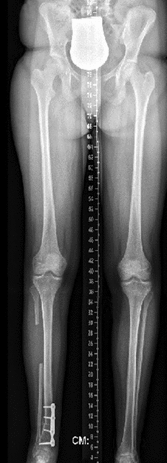Reconstruction of limb deformities in patients with thrombocytopenia-absent radius syndrome
- PMID: 25708036
- PMCID: PMC6583323
- DOI: 10.1111/os.12157
Reconstruction of limb deformities in patients with thrombocytopenia-absent radius syndrome
Abstract
Objective: Developmental abnormalities of the appendicular skeleton are among the most common and easily identified birth defects. The aim of this report was to describe the phenotypic characterization of several patients with thrombocytopenia-absent radius (TAR) syndrome and the orthopaedic interventions performed on them. TAR syndrome is inherited in an autosomal recessive manner and results from compound heterozygosity of RBM8A mutations.
Methods: Reconstructions were designed and performed in five patients with TAR syndrome, mainly comprising orthopaedic interventions to correct their upper limb defects. Additional lower limb deformities (severe internal rotation of the tibiae) was been encountered in one patient.
Results: The affected patients' wrists were re-aligned and stabilized and the musculotendinous forces around the wrist rebalanced to reverse the ulnar forearm bow.
Conclusion: Patients with TAR syndrome who receive optimal treatment can expect to return to most activities of daily living with some limitation of wrist extension and ulnar deviation and, of course, with a reduced total active range of digital motion.
Keywords: Longitudinal radial deficiencies; Reconstruction; Thrombocytopenia-absent radius syndrome.
© 2015 Chinese Orthopaedic Association and Wiley Publishing Asia Pty Ltd.
Figures






References
-
- Alter BP. Thumbs and anemia. Pediatrics, 1978, 62: 613–614. - PubMed
-
- Anyane‐Yeboa K, Jaramillo S, Nagel C, Grebin B. Tetraphocomelia in the syndrome of thrombocytopenia with absent radii (TAR syndrome). Am J Med Genet, 1985, 20: 571–576. - PubMed
-
- Bagnasco J, Stevenson RE. Thrombocytopenia‐absent radius syndrome. Proc Gr Genet Cent, 1988, 7: 36–41.
-
- Behera M, Couchman G, Walmer D, Price TM. Mullerian agenesis and thrombocytopenia absent radius syndrome: a case report and review of syndromes associated with Mullerian agenesis. Obstet Gynecol Surv, 2005, 60: 453–461. - PubMed
-
- Bradshaw A, Donnelly LF, Foreman JW. Thrombocytopenia and absent radii (TAR) syndrome associated with horseshoe kidney. Pediatr Nephrol, 2000, 14: 29–31. - PubMed
Publication types
MeSH terms
Supplementary concepts
LinkOut - more resources
Full Text Sources
Other Literature Sources

